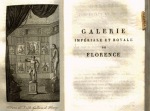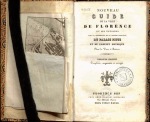Decline of the Classical Grand Tour
Until the end of 1780, the Grand Tour was in full-swing with roughly 20,000 tourists abroad per year. But international politics soon disrupted the heavy flow of Tourists to Florence. In 1789 the French Revolution ripped through France, leaving behind new ideas, turmoil, and uncertainty throughout Europe. The end of the revolution was followed shortly by the Napoleonic Wars between France and Britain, ending only with the Treaty of Paris in 1815. In terms of tourism, this was universally bad for business.
Travel in the 19th century was still hazardous at the best of times but during war it was practically impossible. Despite being unable to travel for over 25 years, the longing for Italy, particularly in Britain and France, was not diminished. Instead, people had to settle for living vicariously through travel literature – reading widely published personal travel accounts, historical works, and guidebooks. This literary genre fed not only the aristocratic desire for Italy but also that of the growing middle-class. Yet, after peace had finally been declared and travelling gradually resumed, all was not as it once had been.
Italia Romantica: Romanticism & Renaissance
As people joined the Tour once more in the 1820s and 1830s their destinations remained relatively the same, but they were much less interested in the accomplishments of ancient Rome and Greece – Romanticism was in vogue. In Italy, tourists generally began to focus on the picturesque countryside that led them from city to city. In Florence, tourists became particularly interested in an era soon to be coined the ‘Renaissance’ in the 1860s by historians Jules Michelet and Jacob Burckhardt.
Florence, appreciated as the center of this artistic and cultural revival, was now visited for its Medieval and Renaissance monuments – particularly ones that housed enormous collections of art while being relics themselves, such as the Palazzo Pitti and the Uffizi Gallery. Churches and convents – previously visited for their religious significance – were now appreciated for their architecture or art.
“We gaze and turn away, we know not where,
Dazzled and drunk with beauty, till the heart
Reels with its fulness; there – forever there –
Chain’d to the chariot of triumphal art,
We stand as captives, and would not depart…”
– Lord Byron, 1828
At the beginning of the 19th century, guidebooks added comprehensive lists of the artworks found in Florentine museums and galleries. These inventories were meant to inform the reader without giving a personal opinion on the work – a common writing style at the time. With the new wave of tourists in the 1840s and 1850s these lists were slowly accompanied by more explanation for the pieces, as it was assumed that most middle-class people would not have a ready knowledge of Classical and Renaissance art history. Guidebooks now existed both with opinions of their authors and without, allowing the reader to choose how they wanted to experience the city – as a newcomer or as an already seasoned traveller.











